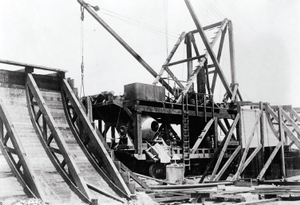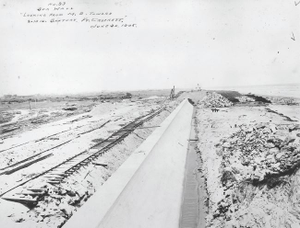During the two years prior to the formation of the board of engineers
and the release of its report, the city of Galveston had already made triumphant strides
in its recovery. A mere 11 days after The Great Storm of 1900, the rail bridge
that connected the Island to the mainland was
completely repaired and operable. Within two weeks, the port was reopened.
In just over a month on October 15, approximately 30,300 bales of cotton
careened out of the harbor, the port’s largest shipment to date. Within three
months the wall of debris was gone and all of the bodies had been disposed,
save for the few that would be discovered months later in the marshy inlets of
the west end.
Elite Galveston business alliances that
formed in the late 1800s, such as The deep water committee, wharf board and the
cotton exchange, worked tirelessly to not only restore Galveston’s prominence as a commercial port
but also expand it. They were not satisfied with the cotton of Texas, the grains of the Midwest, or the minerals of Colorado, Missouri, Kansas and Arkansas.
They also sought the lumber from the forests and mills of the Southwest, and
they sought oil.
They went north and successfully acquired the flour trade. The 1902
fiscal year reported foreign export values of just under $100 million, a record
high that would be shattered by an additional five million reported the
following year.
Interesting things happen to the mindset of a community when complete
devastation makes way for outrageous success, most notably they become
convinced that absolutely anything is possible. Thus to this battered but
resilient population was presented a two-part plan for the fortification of the
city by the board of engineers, a plan that by anyone else’s measure would have
been deemed irreverently audacious and utterly impossible. Reactions varied
from incredulous awe to shocked amazement, but not one person dared to doubt
that it would be done.
The first step of the plan set forth by the board of Robert, Ripley and
Noble was the construction of a 17-foot high seawall that would run along the
perimeter of the southern gulf shore of the city, curve north around the
eastern edge, and end at the harbor.

The face of the wall was designed to be concave to send encroaching
waves upward and back onto themselves, deflecting the force of the water away
from the island: “The wall will be founded on piles and protected from
undermining by sheet piling and also riprap… Its width at the bottom will be
sixteen feet, and at the top its width will be five feet,” the report
stated.
But even a three and a half mile long, 17-foot high wall against the sea
was dwarfed by the second half of the plan, which presented the unimaginable
proposition of elevating the entire city behind the seawall, lifting five
hundred city blocks above the heights of a potentially enraged gulf.
The board recommended raising the grade directly behind the seawall to
match its height, a full 17 feet. Traveling inland towards downtown, an initial
steep decline off the wall would then lead into a more gradual downward slope
measuring one foot per 1,500 feet until Broadway Avenue, where the designated
area to be raised would end with an elevation of four feet. (Because of the
original, eastern border of the seawall, which is presently underneath 6th Street,
the area now known as the East End Historic District was also included in this
plan.

Attached to the report were specific instructions and specifications for
the construction of the seawall, written by the board of engineers and so
detailed and precise that the trio was renamed the seawall board and enlisted
to oversee wall’s construction. But the grade-raising was a task that surpassed
even their own formidable intelligence, as Robert, Ripley and Noble had not the
slightest notion of how it would be achieved.
Even still, the plan met with no opposition. Despite the odds and
uncertainty that hovered on the brink of the seawall’s future completion, Galveston’s Board of
Commissioners and their faithful followers silently ushered forth an unshakable
faith in their future.
The proposed plan of the Board of Engineers was executed almost
immediately, leaving the logistics of how they would fill in behind the seawall
to be determined later. After all an even more daunting question was before the
city, one that demanded immediate attention. However were they going to pay for
it?
Together the construction of the seawall and the grade-raising were
projected to cost a total of $3.5 million, a staggering sum for a city
government still in financial recovery. The enterprising and tenacious Ike
Kempner stepped forward yet again with an answer: perhaps the county would back
the bonds needed to raise the money for the project.
The board of commissioners presented its request on February 3, 1902. At
the time, Galveston
alone accounted for more than 85 percent of the county’s tax base, needless to
say county officials were compelled to offer their full support. Galveston County would back the bonds needed for
the $1.5 million needed to build the seawall.
 An earlier, generous display from the State of Texas
resulted in legislation known as the Act of 1901, a tax levy that provided for
the donation of portions of certain state taxes to Galveston for the city’s recovery. Between
1903 and 1919, four additional acts were passed that would extend this
assistance for a total of 37 years, but instead of being directed towards
recovery efforts these later acts stipulated that the monies were to be placed
into a sinking fund. This fund would back the interest payments for $2 million
in bonds that the city would eventually issue to finance the
grade-raising.
An earlier, generous display from the State of Texas
resulted in legislation known as the Act of 1901, a tax levy that provided for
the donation of portions of certain state taxes to Galveston for the city’s recovery. Between
1903 and 1919, four additional acts were passed that would extend this
assistance for a total of 37 years, but instead of being directed towards
recovery efforts these later acts stipulated that the monies were to be placed
into a sinking fund. This fund would back the interest payments for $2 million
in bonds that the city would eventually issue to finance the
grade-raising.
It was a resounding victory for Galveston.
The county’s backing fully secured the inevitability of the first half of the
plan, while the state’s aid infused stability into the city’s coffers. By the
time the seawall was completed, Galveston’s
financial situation would be so remedied as to allow for the autonomous
financing of the grade-raising.
This also meant that one of the most outstanding feats of civil
engineering in the history of the United States would ultimately be
accomplished without any federal assistance.